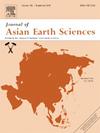伊朗中部Alborz古生代构造演化:从Gondwanan活动边缘到Cimmerian被动边缘的持续延伸
IF 2.7
3区 地球科学
Q2 GEOSCIENCES, MULTIDISCIPLINARY
引用次数: 0
摘要
伊朗北部的阿尔博尔斯山脉以构造反转和造山活动而闻名。古生代、前西元纪断裂和盆地在西元纪和晚阿尔卑斯-喜马拉雅造山期起着关键作用。然而,奥尔布尔斯山脉的古生代构造地质和构造演化,尽管保存完好,暴露范围广,但相对较少受到关注。本文的目的是阐明古生代构造格架和地球动力体制的转变。为此,在地层岩石学研究的支持下,从古应力场分析出发,提出了鄂博士中部古生代应力场的演化。为了获得尽可能高的时间分辨率,并排除较年轻或可能重新激活的断层,每个应力张量代表一个单一地层中新形成的同沉积断层群。计算得到的古应力张量揭示了从冈瓦纳活动边缘到西米叠世裂谷后被动边缘的连续地球动力学过程中贯穿古生代的南北伸展应力体系。伸展是由边缘平行的正断层调节的,包括在后期反转和伸展阶段反复激活的主要盆地边界断层。结果表明,在后期的变形阶段没有垂直轴的旋转,这与晚新近纪奥尔波尔斯山脉内部变形和造山斜弯曲的模式相一致,该模式将奥尔波尔斯中部置于旋转的东西分支之间的枢纽。本文章由计算机程序翻译,如有差异,请以英文原文为准。
Paleozoic tectonic evolution in central Alborz (Iran): Continuous extension from Gondwanan active margin to Cimmerian passive margin
The Alborz Mountains of northern Iran are well known for inversion tectonics and active mountain building. The Paleozoic, pre-Cimmerian faults and basins played a key role in the Cimmerian and late Alpine-Himalayan orogenic phases. However, the Paleozoic structural geology and tectonic evolution of the Alborz Mountains have received comparatively little attention, despite their excellent preservation and extensive exposures. The aim of this paper is to elucidate the Paleozoic structural-tectonic framework and the transition of geodynamic regimes. To this end, we present the evolution of the Paleozoic stress field from paleostress analysis in central Alborz, supported by stratigraphic and petrologic studies. To obtain the highest possible temporal resolution and to exclude younger or potentially reactivated faults, each stress tensor represents a population of newly formed syn-depositional faults from a single formation.
The calculated paleostress tensors reveal a north–south extensional stress regime throughout the Paleozoic during successive geodynamic regimes, from the Gondwana active margin to the Cimmerian post-rift passive margin. The extension was accommodated by margin-parallel normal faults, including the major basin-bounding faults that were repeatedly reactivated during later phases of inversion and extension. The results indicate the absence of vertical axis rotations from later deformation phases, which is consistent with models for late Neogene internal deformation and oroclinal bending in the Alborz Mountains that place central Alborz at the hinge point between the rotating eastern and western branches.
求助全文
通过发布文献求助,成功后即可免费获取论文全文。
去求助
来源期刊

Journal of Asian Earth Sciences
地学-地球科学综合
CiteScore
5.90
自引率
10.00%
发文量
324
审稿时长
71 days
期刊介绍:
Journal of Asian Earth Sciences has an open access mirror journal Journal of Asian Earth Sciences: X, sharing the same aims and scope, editorial team, submission system and rigorous peer review.
The Journal of Asian Earth Sciences is an international interdisciplinary journal devoted to all aspects of research related to the solid Earth Sciences of Asia. The Journal publishes high quality, peer-reviewed scientific papers on the regional geology, tectonics, geochemistry and geophysics of Asia. It will be devoted primarily to research papers but short communications relating to new developments of broad interest, reviews and book reviews will also be included. Papers must have international appeal and should present work of more than local significance.
The scope includes deep processes of the Asian continent and its adjacent oceans; seismology and earthquakes; orogeny, magmatism, metamorphism and volcanism; growth, deformation and destruction of the Asian crust; crust-mantle interaction; evolution of life (early life, biostratigraphy, biogeography and mass-extinction); fluids, fluxes and reservoirs of mineral and energy resources; surface processes (weathering, erosion, transport and deposition of sediments) and resulting geomorphology; and the response of the Earth to global climate change as viewed within the Asian continent and surrounding oceans.
 求助内容:
求助内容: 应助结果提醒方式:
应助结果提醒方式:


